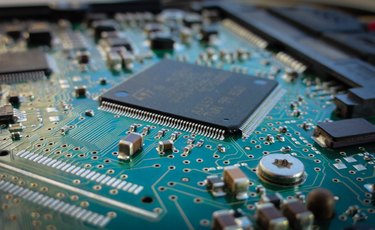
A microprocessor controls all functions of the CPU, or central processing unit, of a computer or other digital device. The microprocessor functions as an artificial brain. The entire function of the CPU is controlled by a single integrated circuit. The microprocessor is programmed to give and receive instructions from other components of the device. The system can control everything from small devices such as calculators and mobile phones, to large automobiles.
History
Video of the Day
Three companies--Intel, Texas Instruments and Garrett Air Research--developed microprocessors around the same period. Intel's 4004 microprocessor is generally accepted to be the first microprocessor. The product was unveiled by the company in 1971. The microprocessor came about in 1969 when a Japanese calculator company called Busicom required the development of a small circuit to control the calculators made by them.
Video of the Day
Features
Microprocessors work based on digital logic. The three components that form the main features of the microprocessor are a set of digital instructions, a certain bandwidth and clock speed that measures the number of instructions that a microprocessor can execute. A series of digital machine instructions are received by the microprocessor. The ALU, or arithmetic logic unit, of the processor does a series of calculations based on the instructions received. Additionally, the unit moves data from one memory to another and has the capacity to jump from one set of instructions to another.
Function
The microprocessor functions through two memories. The read only memory, or ROM, is a program with a fixed set of instructions and is programmed with a fixed set of bytes. The other memory is the RAM, or random access, memory. The number of bytes in this memory is variable and lasts for a short term. If power is switched off the RAM is wiped out. The ROM has a small program within it called the BIOS, or the basic input output system. The BIOS tests the hardware on the machine when it starts up. It then fetches another program in the ROM called the boot sector. This boot sector program executes a series of instructions that helps to utilize the computer effectively.
Considerations
Computers are not merely data processors. Microprocessors should be able to execute instructions in data, audio and video formats. They should support a range of multimedia effects. A 32-bit microprocessor is essential to support multimedia software. With the advent of the internet, microprocessors should have the capacity to support virtual memory and physical memory. They should be able to work with DSP or digital signal processors to handle audio video and playback formats. Fast microprocessors do not require a DSP.
Potential
In this the digital age, there are very few gadgets that do not contain a microprocessor. Advancements in medicine, weather forecasting, automobiles, communications, design and scientific experiments were the results of the development of digital gadgets with microprocessors. Automation for difficult manual jobs is possible because of the microprocessor. The digital logic of microprocessors has led to greater efficiency and speed in all aspects of life. The potential of microprocessor use is therefore immense. Microprocessors ensure lighter, hand-held machinery, imaging and communication systems that have and will improve lifestyles on a global scale.